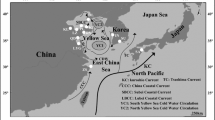Abstract
The biological and taxonomic separation of the Pacific oyster Crassostrea gigas (Thunberg, 1793) from the Kumamoto oyster C. sikamea (Amemiya, 1928) is affirmed by three concordant lines of evidence: (1) fixed differences in 2% of a mtDNA sequence coding for large subunit rRNA; (2) a genetic distance of 0.440 based on 19 allozyme loci, including 5 diagnostic loci (Aat-1, Idh-1, Idh-2, Mpi-1, Mdh-2); (3) one-way gametic incompatibility resulting in partial reproductive isolation in interspecific crosses. C. gigas sperm x C. sikamea egg fertilizations form viable hybrid offspring, but C. sikamea sperm do not fertilize C. gigas eggs. Divergence between these two species is mediated by differing peaks in the periods for gamete release and by one-way sperm/egg incompatibility. Two attempts to recover C. sikamea from its place of origin in southern Japan have yielded only individuals with the mitochondrial haplotype that characterizes C. gigas. We thus identify a crucial need for careful screening, management, and conservation of the cultivated populations of C. sikamea on the US west coast.
Similar content being viewed by others
References
Ahmed M (1975) Speciation in living oysters. Adv mar Biol 13:275–397
Allen SK, Bushek D (1992) Large-scale production of triploid oysters, Crassostrea virginica (Gmelin), using “stripped” gametes. Aquaculture, Amsterdam 103:241–251
Allen SK, Downing SL, Chew KK (1989) Hatchery manual for producing triploid oysters. University of Washington, Seattle, USA (Washington Sea Grant Program, Publ WSG 89-3)
Amemiya I (1928) Ecological studies of Japanese oysters, with special reference to the salinity of their habitats. J Coll Agric imp Univ 9:333–382
Ayala FJ, Powell JR (1972) Allozymes as diagnostic characters of sibling species of Drosophila. Proc natn Acad Sci USA 69:1094–1096
Ayala FJ, Tracey ML, Hedgecock D, Richmond RC (1973) Genetic differentiation during the speciation process in Drosophila. Evolution 28:576–592
Banks MA, Waters C, Hedgecock D (1993) Discrimination between closely related Pacific oyster species (Crassostrea) via mitochondrial DNA sequences coding for large subunit rRNA. Molec mar Biol Biotechnol 2:129–136
Berg CJ (1969) Seasonal gonadal changes of adult oviparous oysters in Tomales Bay, California Veliger 12:27–36
Breese WP, Malouf RE (1975) Hatchery manual for the Pacific oyster. Oregon State University Sea Grant Publ No. ORESU-5-002. Agricultural Experiment Station, Corvallis, Oregon, USA (Spec Rep #443)
Buroker NE, Hershberger WK, Chew KK (1979 a) Population genetics of the family Ostreidae. I. Intraspecific studies of Crassostrea gigas and Saccostrea commercialis. Mar Biol 54:157–169
Buroker NE, Hershberger WK, Chew KK (1979 b) Population genetics of the family Ostreidae. II. Interspecific studies of the genera Crassostrea and Saccostrea. Mar Biol 54:171–184
Chew KK (1979) The Pacific oyster (Crassostrea gigas) in the west coast of the United States. In: Mann R (ed) Exotic species in mariculture. MIT Press, Cambridge, Massachusetts, USA, pp 54–82
Foltz KR, Lennarz, WJ (1993) Review: The molecular basis of sea urchin gamete interactions at the egg plasma membrane. Devl Biol 158:46–61
Grant V (1966) The selective origin of incompatibility barriers in the plant genus Gilia Am Nat 100:99–118
Hedgecock D (1994) Does variance in reproductive success limit effective population sizes of marine organisms? In: Beaumont AR (ed) Genetics and evolution of aquatic organisms. Chapman & Hall, Lond, pp 122–134
Hedgecock D, Banks MA, McGoldrick DJ (1993) The status of the Kumamoto oyster Crassostrea sikamea (Amemiya 1928) in U.S. commercial brood stocks. J Shellfish Res 12:215–221
Hedgecock D, Cooper K, Hershberger W (1991) Genetic and environmental components of variance in harvest body size among pedigreed Pacific oysters Crassostrea gigas from controlled crosses. J Shellfish Res 10:p 516
Hedgecock D, Sly F (1990) Genetic drift and effective population size of hatchery-propagated stocks of the Pacific oyster Crassostrea gigas. Aquaculture, Amsterdam 88:21–38
Imai T, Sakai S (1961) Study of breeding the Japanese oyster, Crassostrea gigas. Tohoku J agric Res 12:125–171
Lannan JE, Robinson A, Breese WP (1980) Broodstock management of Crassostrea gigas. II. Broodstock conditioning to maximize larval survival. Aquaculture, Amsterdam 21:337–345
Leyton L, LeGuen P, Bunch D, Saling PM (1992) Regulation of mouse gamete interaction by sperm tyrosine kinase. Proc natn Acad Sci USA 89:11692–11695
Majima R (1989) Cenozoic fossil naticidae (Mollusca: Gastropoda) in Japan. Bull Am Paleont 96:1–159
Miller DJ, Macek MB, Shur BD (1992) Complementarity between sperm surface β-1,4-galactosyltransferase and egg-coat ZP3 mediates sperm-egg binding. Nature, Lond 357:589–593
Nei M (1978) Estimation of average heterozygosity and genetic distance from a small number of individuals. Genetics, Austin, Tex 89:583–590
Nei M (1987) Molecular evolutionary genetics. Academic Press. New York
Numachi R (1978) Biological research on the oyster. In: Imai T (ed) Aquaculture in shallow seas. Balkema, Rotterdam, pp 115–204
Ozaki H, Fujio Y (1985) Genetic differentiation in geographical populations of the Pacific oyster (Crassostrea gigas) around Japan. Tohoku J agric Res 36:49–61
Palumbi SR (1992) Marine speciation on a small planet. Trends Ecol Evol 7:114–118
Quayle DB (1988) Pacific oyster culture in British Columbia. Can Bull Fish aquat Sciences 218:1–241
Robinson AM (1992) Gonadal cycle of Crassostrea gigas kumanoto (Thunberg) in Yaquina Bay, Oregon, and optimal conditions for broodstock conditioning and larval culture. Aquaculture, Amsterdam 106:89–97
Saiki RK, Bugawan TL, Horn GT, Mullis KB, Erlich HA (1986) Analysis of enzymatically amplified-globin and HLA-DQa DNA with allele-specific oligonucleotide probes. Nature, Lond 324:163–166
Stephano J, Gould M (1988) Avoiding polyspermy in the oyster (Crassostrea gigas). Aquaculture, Amsterdam. 73:295–307
Woelke CE (1955) Introduction of the Kumamoto oyster Ostrea (Crassostrea) gigas to the Pacific coast. Fish Res Pap St Wash 1(3):41–50
Author information
Authors and Affiliations
Additional information
Communicated by M. F. Strathmann, Friday Harbor
Rights and permissions
About this article
Cite this article
Banks, M.A., McGoldrick, D.J., Borgeson, W. et al. Gametic incompatibility and genetic divergence of Pacific and Kumamoto oysters, Crassostrea gigas and C. sikamea . Marine Biology 121, 127–135 (1994). https://doi.org/10.1007/BF00349481
Received:
Accepted:
Issue Date:
DOI: https://doi.org/10.1007/BF00349481




